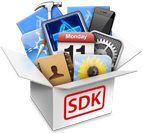IOS SDK
iOS SDK
The iOS SDK (Software Development Kit) is a collection of tools and resources for developing applications for iOS, the operating system for iPhone, iPad, and iPod Touch devices. The SDK is provided by Apple Inc. and includes a comprehensive set of development tools, including Xcode, Instruments, and various frameworks and libraries.
Components[edit | edit source]
The iOS SDK includes several key components:
- Xcode: The integrated development environment (IDE) used for developing iOS applications. It includes a source editor, a graphical user interface editor, and debugging tools.
- Instruments: A performance analysis and testing tool that helps developers profile and optimize their applications.
- iOS Simulator: A tool that allows developers to run and test their applications on a Mac, simulating different iOS devices and configurations.
- Frameworks and Libraries: A collection of pre-built code that developers can use to add functionality to their applications. This includes UIKit, Core Data, Core Animation, and many others.
Development Process[edit | edit source]
Developing an iOS application typically involves the following steps:
1. Setting Up the Development Environment: Installing Xcode and the iOS SDK on a Mac. 2. Creating a New Project: Using Xcode to create a new iOS application project. 3. Designing the User Interface: Using Interface Builder, a part of Xcode, to design the app's user interface. 4. Writing Code: Writing the application's code using Swift or Objective-C. 5. Testing: Running the application in the iOS Simulator or on a physical device to test its functionality. 6. Debugging: Using Xcode's debugging tools to find and fix issues in the code. 7. Profiling and Optimization: Using Instruments to profile the application and optimize its performance. 8. Submitting to the App Store: Preparing the application for submission and submitting it to the App Store for review and distribution.
Frameworks[edit | edit source]
The iOS SDK includes a wide range of frameworks that provide functionality for various aspects of application development:
- UIKit: Provides the core components for building the user interface, including views, controls, and event handling.
- Core Data: A framework for managing the app's data model and persistence.
- Core Animation: Provides advanced animation capabilities for creating rich, interactive user interfaces.
- AVFoundation: A framework for working with audiovisual media, including audio and video playback and recording.
- Core Location: Provides location and heading information to the app, allowing it to determine the device's geographic location.
Related Pages[edit | edit source]
See Also[edit | edit source]
Search WikiMD
Ad.Tired of being Overweight? Try W8MD's physician weight loss program.
Semaglutide (Ozempic / Wegovy and Tirzepatide (Mounjaro / Zepbound) available.
Advertise on WikiMD
|
WikiMD's Wellness Encyclopedia |
| Let Food Be Thy Medicine Medicine Thy Food - Hippocrates |
Translate this page: - East Asian
中文,
日本,
한국어,
South Asian
हिन्दी,
தமிழ்,
తెలుగు,
Urdu,
ಕನ್ನಡ,
Southeast Asian
Indonesian,
Vietnamese,
Thai,
မြန်မာဘာသာ,
বাংলা
European
español,
Deutsch,
français,
Greek,
português do Brasil,
polski,
română,
русский,
Nederlands,
norsk,
svenska,
suomi,
Italian
Middle Eastern & African
عربى,
Turkish,
Persian,
Hebrew,
Afrikaans,
isiZulu,
Kiswahili,
Other
Bulgarian,
Hungarian,
Czech,
Swedish,
മലയാളം,
मराठी,
ਪੰਜਾਬੀ,
ગુજરાતી,
Portuguese,
Ukrainian
Medical Disclaimer: WikiMD is not a substitute for professional medical advice. The information on WikiMD is provided as an information resource only, may be incorrect, outdated or misleading, and is not to be used or relied on for any diagnostic or treatment purposes. Please consult your health care provider before making any healthcare decisions or for guidance about a specific medical condition. WikiMD expressly disclaims responsibility, and shall have no liability, for any damages, loss, injury, or liability whatsoever suffered as a result of your reliance on the information contained in this site. By visiting this site you agree to the foregoing terms and conditions, which may from time to time be changed or supplemented by WikiMD. If you do not agree to the foregoing terms and conditions, you should not enter or use this site. See full disclaimer.
Credits:Most images are courtesy of Wikimedia commons, and templates, categories Wikipedia, licensed under CC BY SA or similar.
Contributors: Prab R. Tumpati, MD

